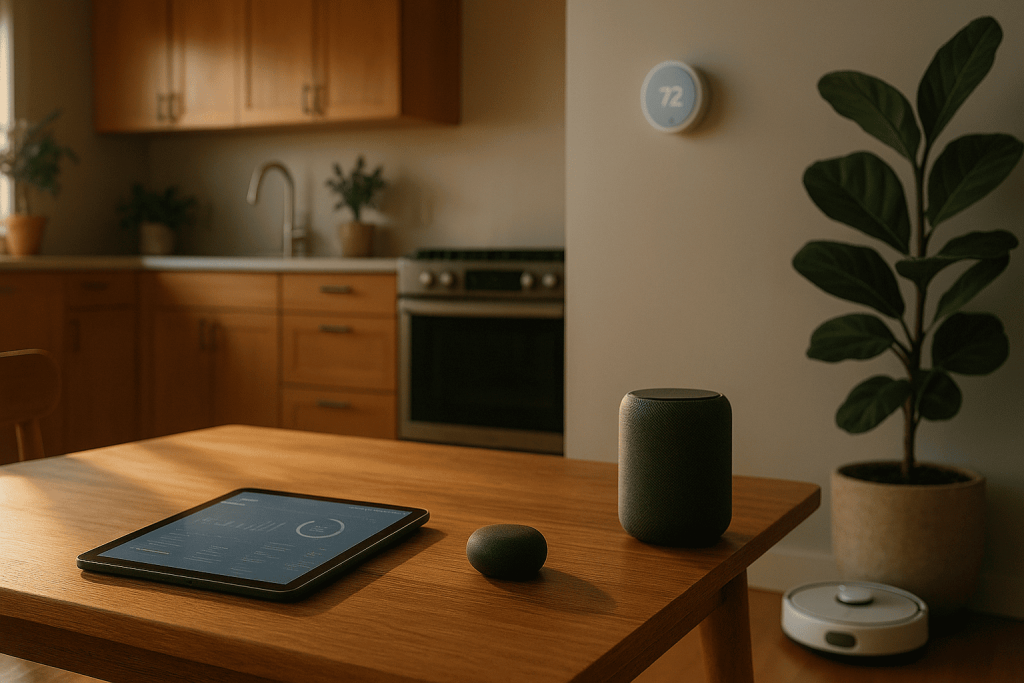Smart homes promised magic, but many of us ended up with isolated gadgets and too many apps. The difference between novelty and real leverage is a simple system: a few reliable workflows where AI collaborates with your appliances, calendars, and preferences to remove everyday friction. This playbook shows how to make AI genuinely useful at home—from food and family logistics to energy, safety, and seasonal maintenance—without turning your living room into a server rack.
Why “realistic” matters
Households run on constraints: budgets, picky eaters, odd schedules, rental rules, patchy Wi-Fi, and the truth that nobody wants a weekly project just to keep the dishwasher happy. A realistic AI home focuses on a handful of high-impact loops, uses devices you already own, and fails gracefully when the internet or a sensor does. Think less sci-fi house, more calm, well-briefed helper.
Meal planning that respects time, taste, and money
Start with a living pantry that tracks staples, brand preferences, allergies, and a few no-go ingredients. Your assistant reconciles what’s in the fridge with upcoming plans, proposes dinner options that meet nutrition targets, and generates a tight grocery list. When you allow it, it will watch for promos and recommend swaps that keep flavor while trimming cost.
Cooking as a collaboration
Ask for a stepwise plan that sequences oven and stovetop to finish together, plus a cleanup-lite variant that minimizes dishes. When you run out of cumin or spinach, prompt for near-taste substitutes and yield adjustments. If you share a quick pantry photo, the assistant can identify items well enough to prioritize use-soon recipes and reduce waste.
Nutrition that’s gentle, not judgmental
Instead of calorie policing, have the AI propose weekly patterns that anchor on protein and fiber, then layer in treats you actually enjoy. It can create kid-friendly variants of the same menu to avoid cooking twice and produce a one-sheet for the fridge with prep notes and reheating directions for leftovers.
Groceries without guesswork
Connect one or two trusted retailers, set strict substitutions for allergies, and define a budget band. The assistant groups items by store, flags price spikes, and suggests pantry restocks when frequently used items drop below your threshold. If delivery windows slip, it reshuffles the week’s meals and points to recipes that still work with what you have.
Cleaning and laundry that don’t steal Saturdays
Replace marathon chores with small, steady loops. The assistant schedules micro-tasks that match your energy patterns, plans vacuum runs when rooms are empty, and proposes a laundry cadence tied to household size and wardrobe. It adds a quick stain-removal decision tree so you can act in seconds instead of doom-scrolling advice.
Energy, comfort, and lower bills
Heating and cooling are the biggest levers. With thermostat access and local tariffs, AI can pre-heat or pre-cool before peak prices, then coast within your comfort band. If you own a heat pump, it recommends smarter schedules and filter changes based on runtime, not guesswork. Even in apartments, it helps by drafting clear temperature logs for landlords and suggesting low-cost fixes like door sweeps or thermal curtains.
Timing appliances for savings
Dishwashers and washing machines can be nudged to off-peak windows, water heaters can avoid reheating when you’re away, and robot vacuums can dodge calls. Over time, the assistant notices patterns and proposes tweaks, like shifting bake nights or batch-cooking to align with cheap energy blocks.
Maintenance without the maybes
Build a simple home brain that stores make, model, serials, filter sizes, warranty dates, and the little details you always forget. AI turns that stash into seasonal checklists with plain-language instructions and links to the right video for your exact unit. When it’s time to replace filters or anodes, it drafts a one-click cart with the correct parts instead of leaving you to guess among near-matches.
Predictive hints that prevent expensive surprises
Even without fancy sensors, the assistant can spot failure patterns from your notes: a fridge that’s louder, a faucet that drips, a breaker that trips after the toaster and kettle run together. It organizes symptoms, suggests likely causes, and gives you the language to talk to a pro—or the confidence to fix it yourself.
Family logistics that restore sanity
With access to shared calendars, school memos, and travel plans, the assistant proposes a weekly one-pager: events, drive times, meal anchors, and two likely friction points with suggested resolutions. Chores become a fair rotation with bite-size tasks; the assistant nudges the right person at the right time and acknowledges completion so the system feels cooperative, not punitive.
Wellness at home: light, air, sleep
Good days start with good nights. Ask the assistant to build wind-down routines that dim lights, cool the bedroom, silence non-urgent notifications, and set a do-not-disturb exception for specific contacts. With an air sensor, it cues window openings or purifier runs when particulates or CO₂ rise and learns which rooms need attention first.
Safety, privacy, and consent by default
Treat microphones like cameras: clear opt-in, visible listening indicators, and a physical or on-screen kill switch. Store only what the household agrees to keep, mask names and addresses in logs, and make deletion a plain-English command. If you use cameras or doorbells, respect guest zones and avoid face recognition unless everyone has opted in. Small printed notices build more trust than buried settings.
Voice and chat that actually help
Voice excels in the kitchen and garage for short commands and updates; chat shines when you want a visible plan. Aim for a human pattern: brief acknowledgment, concise summary, and the next best step. When unsure, the assistant should ask one smart clarifying question rather than launching a quiz.
Pick three workflows first
Start where pain is loud and success is obvious. Meal planning saves time and money. Maintenance prevents expensive stress. Calendar choreography prevents last-minute chaos. Implement those three, enjoy the wins, then consider stretching into security automations or complex energy dashboards.
Your home as data—just enough
You don’t need sensors everywhere. A few well-placed devices, like a thermostat, a leak detector near the water heater, and a smart plug for the always-forgotten iron, deliver outsized value. The assistant doesn’t need to know everything; it needs enough context to offer good suggestions and the humility to ask when it’s not sure.
Fail gracefully and keep humans in charge
Great systems degrade politely. If the internet dies, the assistant queues tasks and gives a simple status when you’re back. If a device stops responding, it offers a manual workaround. Any automation that could cost money or frustrate guests should have an easy, physical override, and the assistant should always state what it changed and why.
Money, ROI, and subscription sanity
Set a monthly ceiling for smart services, track energy savings and waste reduction, and cancel what doesn’t earn its keep. Ask the assistant for a simple memo that shows whether a gadget or plan is worth it. Less is usually more.
Get started this week
Write a one-page home brief with allergies, budget guardrails, comfort bands, schedules, and don’t-touch zones. Connect a calendar, a grocery service, and a thermostat or a single smart plug. Ask the assistant for a weekly bundle: menu, grocery list, calendar conflicts with fixes, and a tiny maintenance task with a how-to. Run that loop for a week, then adjust based on what felt easy versus annoying.
What to expect next
On-device AI is improving fast, so more decisions will happen locally with less lag and fewer privacy trade-offs. Appliances will speak a common language, making cross-brand coordination less of a hack. The most noticeable change won’t be dazzling features—it will be the quiet disappearance of small frictions that used to siphon afternoons.
Conclusion
A realistic AI home is a quiet one. It notices patterns without prying, suggests instead of nags, and turns everyday hassles into small, well-timed nudges. Start with a few loops that matter—food, time, comfort—set clear guardrails, insist on transparency and consent, and let the system earn your trust. Do that, and your home won’t feel high-tech; it’ll feel like it’s finally on your side.


